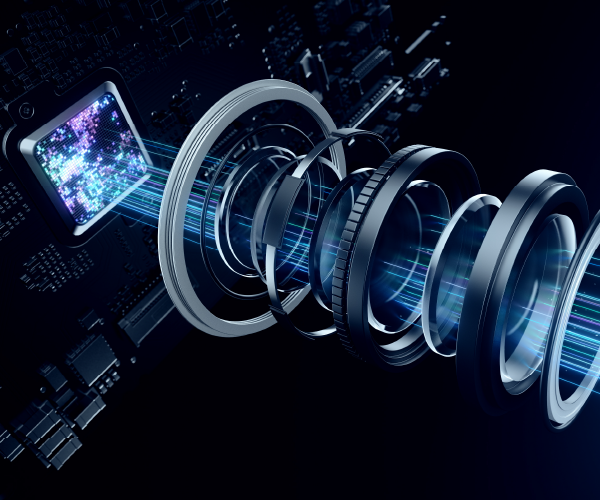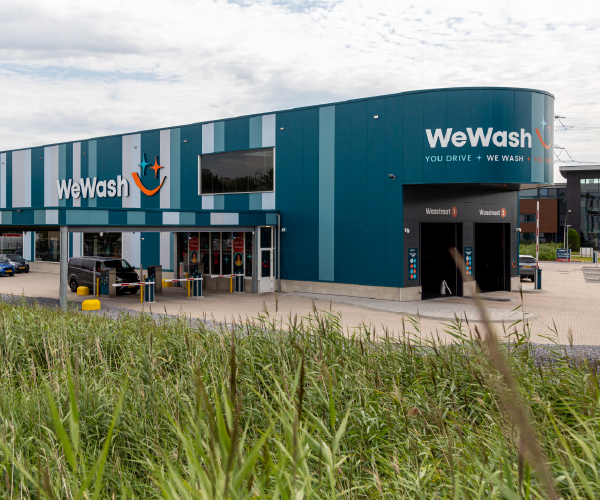
Sensors Shaping the Future of Car Wash Tech
July 2, 2024
8 minute ReadOperators use sensor data to provide more personalized and safer car washes.
Sensors aren’t new to the car wash industry; they’ve been used for decades to control everything from opening and closing car wash doors in cold climates to starting the washing process. But today’s photoelectric (photo eye) and ultrasonic sensors, paired with sophisticated controller software that analyzes their collected data, do much more.
Customization Boost
The detailed vehicle information sensors provide can deliver a more customized wash.
For example, ultrasonic sensors, mounted on the sides or top of the car wash bay, emit sound waves that hit the vehicle and are reflected back to the sensor. The car wash controller system uses this data to determine the vehicle’s width and its angle in the bay, then automatically adjusts the spray arms and brushes for the vehicle’s wash.
Light curtain technology that incorporates photoelectric sensors provides a more detailed vehicle profile. D&S Car Wash’s light curtain technology, the IQ2.0 Touch Free and Soft Touch systems, consists of two seven-foot columns of 48 photo electric sensors from Telco, vertically spaced 1.5 inches apart. The poles are placed on either side of an arch that spans the vehicles. Transmitting sensors on one pole pair with receiver sensors on the other pole.
“The sensors emit an array of infrared beams, and based on which ones are blocked by a vehicle, the IQ2.0 software can construct a profile of the vehicle,” said Addyson Salalila, senior technician at TNT Touchless, Inc., which distributes the IQ2.0 systems.
The sensors are constantly collecting data as the arch passes over the vehicle in the wash bay. “We get a new data set about every inch or so, then we’re able to pull all of these data sets together to get an extremely accurate profile of what the vehicle looks like,” said Jerry Canfield, D&S’ chief innovation officer. “That includes all kinds of little shapes and sizes, whether it’s a fairing or a special kind of hood scop. It shows where the tires and wheels are located, how high the vehicle is off the ground — all kinds of details, so that we know the actual shape and size of the car.”
Photo eye sensors are not able to determine a vehicle’s width or location in the bay, however. So the IQ2.0 system uses ultrasonic sensors to collect that information. The combined data from the two types of sensors creates a 3D image of the vehicle.
The sensors make the car wash more intelligent, too, so it can determine exactly where the car is and can move the brushes in or out of the top boom and up or down to accommodate its shape. “It allows any car to be washed because the photo eyes are able to see any obstructions on the car, like a roof rack or a wheelchair lift,” Salalila said. The light curtain sensors also pick up features like truck rear windshields, so the system can position the nozzles pointing backward to clean those areas.
Photoelectric sensors continue to improve over time. Telco, for example, recently began coating its circuit boards with chemical-proof plastics to provide further protection in the harsh car wash environment. “But the real advancements have been on the software side,” Canfield said. “We’ve spent a lot of time and effort taking all the data that’s coming in here to make these amazing images.”
New sizing options are being explored now, too, so they can be used with a larger variety of vehicles. D&S is now offering a double-height, longer light curtain for vehicles up to 14 feet high and 100 feet long — larger vans, construction vehicles and other trucks that don’t fit within a traditional car wash.
No matter what size the vehicle, the light curtain technology provides a more sustainable solution, since the car wash applies chemicals and water more precisely depending on the car’s size, shape and configuration.
“It saves water, it saves chemicals, it saves everything,” said Richard Livengood, president, Telco Sensors Inc. “If you can get as close as possible to the vehicle to remove the dirt, the bugs, and whatever else, you don't need as much water, you don't need as much soap, you don't need as many chemicals.”
Sensors for Robotic Operations
The integration of sensors with AI and advanced robotics could bring major changes to car washes. One example is Clinpify, a Spanish company that anticipates launching its autonomous, AI-guided car wash robots in Europe in about a year.
“We have been working for more than a year on a new generation of autonomous AI-guided robots as a revolutionary alternative to the old traditional roller wash tunnels,” said Alberto Zarco, Clinpify’s founder/CEO. These car wash robots can engage in contact or contactless washing and can adapt to each vehicle by leveraging AI capabilities — and getting smarter with every wash.
Sensors are key in the Clinpify system. “We combine vision technologies, which work like a human eye and allow us to see the car, and other 3D sensors like LiDAR,” Zarco said. The robotic arms also use a multitude of proprietary sensors to control the position of the robot, the distance to the car and even the level of friction force used for contact washing.
The data collected by the vision technology and the system’s sensors includes level of dirt, type of dirt, location of the dirt, when the surface is clean, and the level of wear of parts such as tire rubber, age and condition of the vehicle, color, etc. Once the robots determine the exact geometry of the vehicle and identify the most and least dirty areas, the system adjusts the wash to each car’s specific characteristics. Clinpify’s custom-designed robotic arms, which will wield either brushes or high-pressure wands, are flexible enough to reach difficult-to-access areas on a vehicle, like recesses, air outlets and overhangs.
“All this allows us to make an intelligent use of water, energy and other supplies, while allowing us, through our recommendation algorithm, to suggest the best time to wash the car and keep it always in its best health,” Zarco said. “That is why we say that we do not wash cars, but through our technology we apply intelligence to the washing of the vehicle.”
Future possibilities
As sensor technology advances, car wash innovators will be searching for ways to adapt it to the industry’s needs.
One possibility is sSy.ai, which is using its neural networks (AI machine learning) to transform standard video cameras into high-precision sensors. Among other capabilities, this system provides object recognition and visualizations, which could be used for contouring vehicle profiles in car washes. This could help eliminate potential problems like an open window in a vehicle in the car wash bay. Since the system can also track objects in real time, it might be able to detect potential vehicle collisions in the tunnel as well.
sSY.ai has worked with material handling partners and recently won an innovation award from MHI for its system. But the company is eager to work with other industries as well. “I would love to learn about the challenges in the car wash business and then find solutions that would help,” said Thomas Zoehrer, the company CEO/co-founder.
Another sensor-based technology that could impact car washes is Owl Autonomous Imaging, which is designed for installation on vehicles to reduce the incidence of nighttime collisions. Its passive 3D sensor solution uses AI deep learning and custom thermal sensors.
“The Owl thermal camera can see in the dark, in total darkness, as well as in rain, snow and fog,” said Mark Shapiro, who handles PR for Owl Autonomous Imaging. The cameras recognize the heat that warm objects — such as people and animals — emanate. Used in conjunction with AI, it can be trained to identify what the warm object is and calculate how far away it is.
This feature could be a major step in helping keep pedestrians safer at night, especially when walking in the same vicinity as vehicles. In 2021 over 75% of pedestrian deaths occurred in the dark, according to an article in The New York Times.
The same capabilities could help with safety at a car wash, too, minimizing the risks of injury to employees on site, pedestrians walking by or people outside of their vehicle at the car wash engaged in washing mats, emptying their garbage or using a vacuum station, for example.
Sensors That Reduce Crashes
Crashes at the exit of the tunnel are expensive problems for car washes. Operators can be stuck with thousands of dollars in repair costs if a car piles into a previous vehicle that is stopped at the end of the tunnel.
Positioned at the car wash exit, crash pads equipped with metal-detecting sensors called magnetometers can help prevent those rear-end collisions. “A car may be at the exit, just off the conveyor and still sitting there, and another car is coming up behind it. When that [second] car gets to a certain point, and the system detects that there is already metal over this crash pad, it will stop the belt,” said Robert Giannone, president, Big Sammy’s Car Wash.
Big Sammy’s recently began using Laguna Industries’ enhanced crash pad which also detects if a car is stuck and hamster wheeling at the end of a flat belt conveyor. Giannone said this new feature is a game changer for washes with a flat belt conveyor because it’s a cost effective solution to a common issue. If the vehicle doesn’t arrive at the crash pad at the right time, the controller stops the conveyor until the vehicle is off the belt and out of the way. Giannone said Laguna’s enhanced crash pad has eliminated all exit collisions at his two car wash locations.
Sensor Cleaning
Sensors can only work as well as they can see. If their field of vision is compromised, so is the data they are able to supply. “Those advanced safety systems need the sensors and cameras to be clean and clear so they’ll work when you really need them,” said Consumer Reports Autos Editor Jon Linkov.
The backup camera, bumper sensors for parking assist, blind spot monitoring cameras and even radar sensors located in the front grill may need extra attention. If the car has forward collision or lane departure warning, check the windshield carefully where those sensors and cameras are usually housed. Also, check the mirror area if there is a 360-degree camera system.








